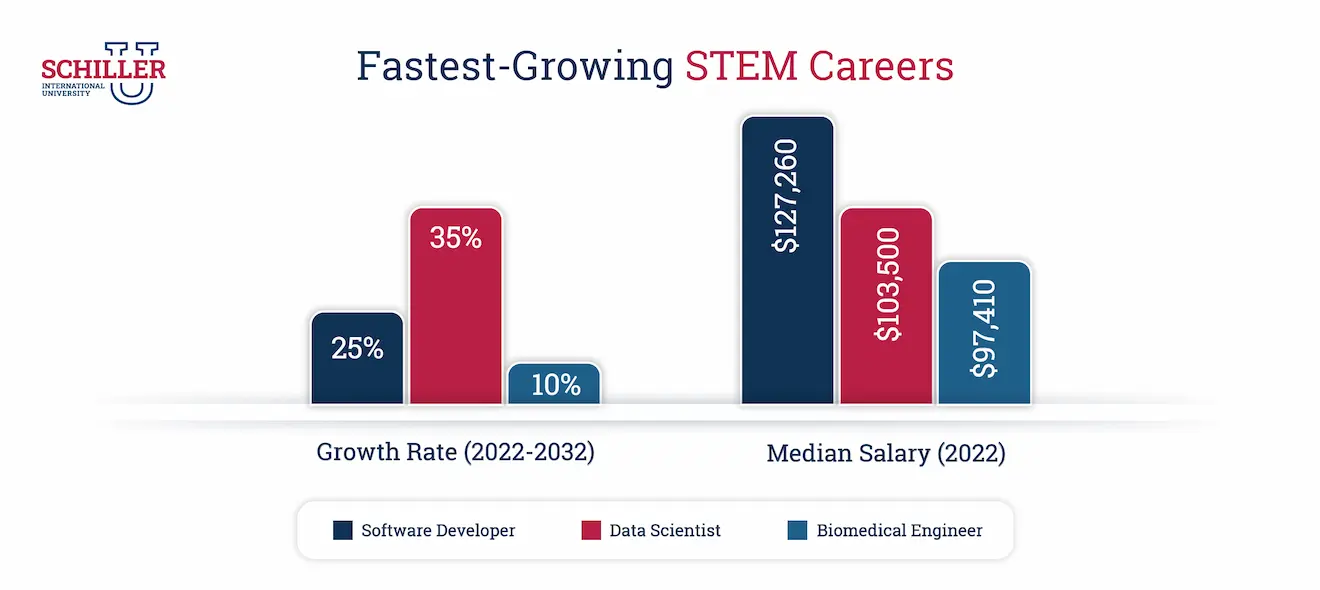Have you ever wondered what a STEM degree is and why it is so important in today’s job market? STEM stands for science, technology, engineering, and mathematics. But it is far more than an acronym. They are four powerhouse fields fueling everything from life-saving medical breakthroughs to apps on your phone.
If you are curious about solving real-world problems, building cutting-edge technology, or exploring the universe, a STEM degree might just be your key to a global career. For international students eyeing the US job market, this is your golden ticket.
What is a STEM Degree?
A STEM degree is an academic program that falls under these four broad categories: Science, Technology, Engineering, or Mathematics. These disciplines are the backbone of innovation, tackling challenges like climate change, cybersecurity, and medical advancements. Whether you are interested in software development, biomedical engineering, or data science, a STEM major gives you tools to solve problems, think critically, and innovate.
The U.S. Bureau of Labor Statistics projects that STEM jobs will grow by 10.8% from 2021 to 2031, outpacing non-STEM jobs by more than double.
A quick look at each area:
Science
Covers natural sciences (biology, chemistry, physics) and formal sciences (mathematics, statistics). Think of studying ecosystems or unraveling DNA’s secrets.
Technology
Applies science to create tools and systems, like software development or information technology. It is about building the technology that runs our world.
Engineering
Involves designing and building everything from bridges to spacecraft. Fields include mechanical engineers, electrical engineers, and biomedical engineers.
Mathematics
The foundation for problem-solving, used in data analysis, modeling, and more. It is the language of the STEM disciplines.
STEM Degree List Examples:
| Field | Example Degrees |
| Science | Biology, Chemistry, Physics |
| Technology | Computer Science, Information Systems |
| Engineering | Electrical, Mechanical, Biomedical Engineering |
| Mathematics | Applied Mathematics, Statistics, AI |
Key Features of STEM Degrees:
- Focus on hands-on learning and real-world applications
- Emphasis on analytical, technical, and creative thinking
- Prepares students for high-demand, high-growth careers
These degrees prepare you for a STEM career with hands-on learning and problem-solving skills. Whether you are analyzing data or designing sustainable systems, a STEM degree sets you up to make a difference.
Why a STEM Degree Matters More Than Ever
A STEM degree trains you to tackle challenges like cybersecurity threats, sustainable energy gaps, or data-driven business decisions.
Some important reasons to consider:
- Better Pay: STEM careers often pay more. STEM workers earn a median salary significantly higher than non-STEM workers, sometimes up to 40% more.
- Global Opportunities: STEM education is valued worldwide, letting you work in diverse countries and industries, from tech hubs to research labs.
- Impactful Work: STEM fields let you tackle big issues, think curing diseases or fighting climate change. Your work could change your lives.
- Extended OPT for International Students: In the U.S., a STEM degree grants up to 36 months of Optional Practical Training (OPT), giving international students valuable work experience.
Choosing a STEM degree means investing in a future where your skills are in demand; your paycheck reflects it, and you are making a real impact.

STEM Career Growth: The Numbers Speak
A STEM degree is not just a diploma—it is employability armor. LinkedIn data shows 70% of US employers prioritize STEM talent.
Roles like data scientists or sustainability strategists did not exist 15 years ago.
Wondering if a STEM career is worth it?
Here’s what the numbers say.
The U.S. Bureau of Labor Statistics reports that STEM occupations are expected to grow by 10.8% between 2022 and 2032, compared to just 2.3% for all other jobs. Median pay for STEM jobs is nearly double the national average. Roles such as software development, biomedical engineering, and data science are among the highest paid.

With Schiller’s industry ties, you’ll network with LOEWE, Goya Foods, and 20,000 alumni worldwide.
STEM Degree Programs
STEM degree programs come in various areas, from bachelor’s degrees to master’s degrees in STEM, each tailored to different career goals.
The breakdown is as follows:
Bachelor’s Degree in STEM
A bachelor’s degree in STEM typically takes four years and builds a strong foundation.
Popular bachelor’s programs include:
- Computer Science: Code the future. Learn programming, algorithms, software development, focus on AI, cloud systems, or cybersecurity for technology-driven careers. At Schiller, the BSc in Computer Science integrates Python and machine learning—tools used by Netflix and NASA alike.
- Applied Mathematics and Artificial Intelligence (AI): Crunch numbers, train algorithms. Blend math with AI to master data analysis and machine learning. Schiller’s BSc in Applied Math and AI tackles large language models—think ChatGPT’s next-gen cousins.
Master’s Degree in STEM
A master’s degree in STEM offers specialization in one to two years. At Schiller, you can get your master’s degree in 10 months.
Popular master’s programs include:
Data Science: Turn data into strategy. Focus on data science, statistical modeling, and big data for roles like data analyst or AI engineer. The MS in Data Science at Schiller packs machine learning and PowerBI into 10 months.
Sustainability Management: Fix the planet. The MS in Sustainability Management covers renewable energy systems and ESG policies—skills booming in Fortune 500 firms.
Regardless of your starting point, there is a STEM degree program to match your ambitions.
Growing Fields in STEM
The STEM field is buzzing with growth, especially in areas shaping the future.
Here are some hot STEM disciplines:
- AI: AI powers everything from chatbots to self-driving cars. It’s about creating smart systems, with roles like AI specialists growing fast.
- Data Science: Data science professionals analyze massive datasets to drive decisions, with demand soaring as businesses become data driven.
- Renewable Energy: With a push for sustainability, engineers work on solar, wind, and hydro solutions, addressing global energy needs.
- Biotechnology: Combining biology and technology, this field advances medicine and agriculture, with roles such as biomedical engineers in high demand.
- Cybersecurity: Protecting information systems from cyber threats is critical, with jobs growing as digital reliance increases.
These fields offer exciting career paths for STEM majors, with the U.S. needing 3.5 million STEM jobs filled by 2025 (Cognizant).
Schiller International University’s STEM Programs
For international students eyeing a STEM degree, Schiller International University offers cutting-edge STEM programs designed for global success.
STEM Programs include:
- Bachelor of Science in Computer Science: Covers programming, AI, and database systems, preparing you for tech roles.
- Bachelor of Science in Applied Mathematics and AI: Combines math and AI for careers in data analysis and machine learning.
- Master of Science in Sustainability Management: Focuses on sustainable practices, with UNITAR certification for global impact.
- Master of Science in Data Science: Trains you in data science, machine learning, and big data analytics.
With campuses in Madrid, Paris, Heidelberg, and Tampa, Schiller’s STEM programs emphasize practical learning and global employability, perfect for international students.
The Global Edge: Dual Degrees and International Campuses
You’ve got options. But Schiller merges American pragmatism with global agility:
- Dual U.S./European degrees: Graduate with credentials from Schiller and the University of Roehampton—no extra time or cost.
- Study Across 4 Countries: Start in Tampa, then shift to Paris, Madrid, or Heidelberg. Cultures change; your degree program stays seamless.
- OPT Advantage: Work three years in the US post-graduation, then pivot globally.
- Hybrid Flexibility: Most courses blend online sync sessions with one on-campus week. Fit a master’s degree in STEM around internships.
- Tampa’s Tech Hub: The campus sits in Florida’s fastest-growing technology corridor—with 10+ Fortune 500 neighbors.
Launch Your STEM Journey with Schiller
Understanding what a STEM degree is, and its key concepts, is your first step toward a borderless career. STEM stands for science, technology, engineering, and mathematics, offering opportunities to innovate and solve global challenges.
From bachelor’s degrees in STEM to master’s degrees in STEM, these programs will equip you with the skills for a competitive job market. For international students, a STEM degree means global opportunities and, in the U.S., extended OPT for work experience.
At Schiller International University, you’ll earn more than a credential; you will build a global network, master in-demand skills with international exposure, and gain three years of US work access.
Apply Now to Schiller’s STEM Programs and work anywhere tomorrow.
FAQs
Q1: What are the benefits of STEM degrees?
Answer: A STEM degree gives you hands-on skills, sharp thinking, and a chance to land high-paying jobs. You will learn to solve real problems and work with the latest technology. Employers everywhere—from start-ups to big companies—value the practical experience and adaptability that STEM graduates bring.
Q2: How do STEM degrees contribute to innovation and research?
Answer: STEM degrees encourage you to ask questions, test ideas, and build new solutions. Whether you are in a laboratory, at a computer, or designing a product, you will be part of teams that push boundaries and create new knowledge. This mindset fuels breakthroughs in everything from medicine to AI.
Q3: What career opportunities are available after a STEM degree?
Answer: Graduates can find work in technology, engineering, healthcare, finance, and more. You could become a software developer, data scientist, engineer, or analyst. Many STEM graduates go on to work in leadership roles, conduct research, or establish their own businesses.
Q4: Are STEM degrees only for students who are good at math and science?
Answer: Not at all. While math and science help, curiosity and problem-solving matter more. STEM programs are available to students of all backgrounds. If you like asking questions and finding solutions, you will fit right in.
Q5: Is a STEM degree useful for international students?
Answer: Absolutely. STEM degrees are recognized worldwide and open doors in many countries. International students with STEM backgrounds often qualify for extended work visas and find jobs faster thanks to their in-demand skills.

 Request information
Request information









